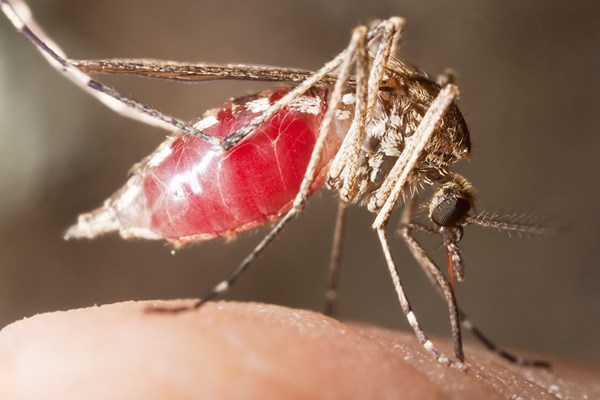 Credit: Thinkstock Feeding habits, the ability to sustain and pass viruses, and host preferences for blood meals affect the potential for some mosquito species to serve as disease vectors.
Credit: Thinkstock Feeding habits, the ability to sustain and pass viruses, and host preferences for blood meals affect the potential for some mosquito species to serve as disease vectors.Kentucky is home to more than 50 species of mosquitoes with a range of breeding sites and survival strategies. Some thrive when above-normal rainfall creates temporary ground pools; others develop in small accumulations of stagnant water during dry periods.
Many of our mosquito species spend the winter as freeze-resistant eggs that can survive prolonged harsh conditions. A few, such as the house mosquito (Culex pipiens), spend the winter as adults in protected places. They are vulnerable to severe cold, but like most insects have the reproductive capacity to build numbers by late summer, even if winter mortality is high.
Several mosquito species feed on horses with varied effects that range from adverse skin reactions to disease transmission. Proteins injected in mosquito saliva can produce irritating bites that can cause skin reactions in sensitive individuals. The inland floodwater mosquito (Aedes vexans) is a widespread pest that can develop in any ground pool that lasts 10 to 14 days. It causes a significant and chronic problem in some parts of the state and can give rise to several generations each year. Females rest on vegetation and shaded grass during the day and bite viciously at dusk and after dark. They can live for several weeks and may travel several miles during that time. Feeding by large numbers of these mosquitoes at night can produce dermatitis and itching in horses on pasture.
Feeding habits, the ability to sustain and pass viruses, and host preferences for blood meals affect the potential for some mosquito species to serve as disease vectors. Some mosquito species feed primarily on mammals, others on birds, and some are opportunistic. Ornithophilic mosquitoes (Culex pipiens group) can maintain an avian cycle of Eastern equine encephalitis, Saint Louis encephalitis, and West Nile viruses among various bird species. Some of these mosquitoes serve as bridge vectors for viruses when they initially feed on infected birds and then take blood meals from mammals.
The rapid spread of West Nile virus across the U.S. required quick action to manage vector mosquitoes in an effort to protect equines and humans. Mosquito management takes a multi-pronged approach including source reduction, screens, and protection using repellents and insecticide s. Fortunately, a combination of factors—selection for immunity in the avian population, development and registration of a vaccine, and mosquito management— were instrumental in quickly reducing the annual number of equine cases from a high of 513 in 2002 to 8 in 2004. A few cases have been diagnosed each year since 2004, but vaccination has played a significant role in keeping the incidence low. A sound prevention program, which includes mosquito management is an important part of keeping the disease in check.
The Zika virus and yellow fever mosquito (Aedes aegypti) have captured the headlines in recent weeks. The yellow fever mosquito is not a part of Kentucky’s mosquito population, and there is no indication that Zika virus affects equines. However, there are human health concerns. The larvae of this mosquito can develop in small accumulations of water (as little as 1/4 inch deep) in artificial or natural containers. It is an aggressive day biter that is most active in early morning and late afternoon. Usually, it moves only 100 to 300 yards from its breeding site, so breeding-site reduction can be an important aspect of managing this species. Repellents containing DEET are very effective at protecting people from being bitten in late August, when this mosquito is most abundant.
For more information contact author Dr. Lee Townsend at lee.townsend@uky.edu. Subscribe to the Equine Disease Quarterly online. The Equine Disease Quarterly is funded by Underwriters at Lloyd’s, London, Brokers and their Kentucky Agents.


